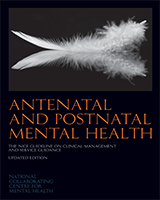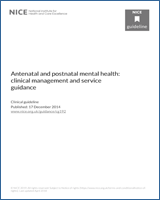NCBI Bookshelf. A service of the National Library of Medicine, National Institutes of Health.
National Collaborating Centre for Mental Health (UK). Antenatal and Postnatal Mental Health: Clinical Management and Service Guidance: Updated edition. Leicester (UK): British Psychological Society; 2014 Dec. (NICE Clinical Guidelines, No. 192.)
April 2018: Footnotes and cautions have been added and amended by NICE to link to the MHRA's latest advice and resources on sodium valproate. Sodium valproate must not be used in pregnancy, and only used in girls and women when there is no alternative and a pregnancy prevention plan is in place. This is because of the risk of malformations and developmental abnormalities in the baby.

Antenatal and Postnatal Mental Health: Clinical Management and Service Guidance: Updated edition.
Show detailsReview questions
| Experience of care |
|---|
| 1.1 What factors prevent women with a mental health problem who are antenatal or postnatal accessing mental healthcare services? 1.2 What factors improve or diminish the experience of services for women with a mental health problem who are antenatal or postnatal? 1.3 What modifications to services improve the experience of using services for women with a mental health problem who are antenatal or postnatal? |
| Prevention |
| 2.1 What is the effectiveness of selective preventative interventions in reducing the likelihood of developing mental health problems for women who are antenatal or postnatal? 2.2 What is the effectiveness of indicated preventative interventions in reducing the likelihood of developing mental health problems for women who are antenatal or postnatal? 2.3 What strategies should be adopted to minimise potential harm to the women or the fetus/infant of these interventions? |
| Case identification and assessment |
| 3.1 What concerns and behaviours (as expressed by the woman, carer and family, or exhibited by the woman) should prompt any professional who comes into contact with woman who is antenatal or postnatal to consider referral or further assessment for the presence of mental health problems? 3.2 What are the most appropriate methods/ instruments for the identification of mental health problems in women who are antenatal or postnatal? 3.3 For women who are antenatal or postnatal, what are the key components of, and the most appropriate structure for a comprehensive diagnostic assessment (including diagnosis)?? Consider:
|
| Interventions for the treatment of mental health problems |
| 4.1 For women with mental disorders who are antenatal or postnatal, what are the benefits and/or potential harms of psychosocial interventions to treat mental health problems? 4.2 For women with mental disorders who are antenatal or postnatal, what are the benefits and/or potential harms of pharmacological interventions to treat mental health problems? 4.3 For women with mental disorders who are antenatal or postnatal, what are the benefits and/or potential harms of combined pharmacological and psychosocial treatment interventions to treat mental health problems? 4.4 For women with mental disorders who are antenatal or postnatal, what are the benefits and/or potential harms of electroconvulsive therapy to treat mental health problems? 4.5 For women with mental disorders who are antenatal or postnatal, what are the benefits and/or potential harms of interventions targeted at improving the quality of the mother-child interaction? 4.6 What is the role of the family, carers and peers in the treatment and support of women with mental health disorders in pregnancy and the postnatal period? |
- ANALYTIC FRAMEWORK AND REVIEW QUESTIONS - Antenatal and Postnatal Mental HealthANALYTIC FRAMEWORK AND REVIEW QUESTIONS - Antenatal and Postnatal Mental Health
- SCOPE FOR THE DEVELOPMENT OF THE CLINICAL GUIDELINE - Antenatal and Postnatal Me...SCOPE FOR THE DEVELOPMENT OF THE CLINICAL GUIDELINE - Antenatal and Postnatal Mental Health
Your browsing activity is empty.
Activity recording is turned off.
See more...

